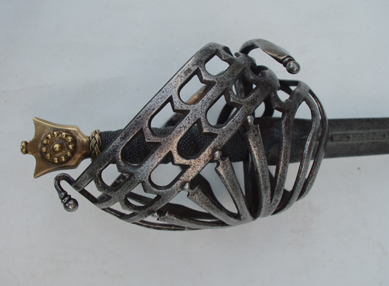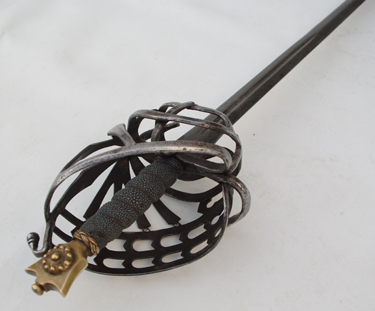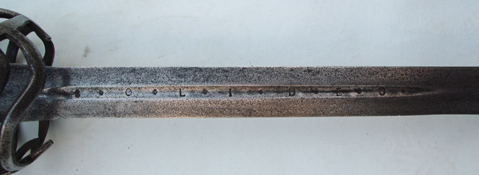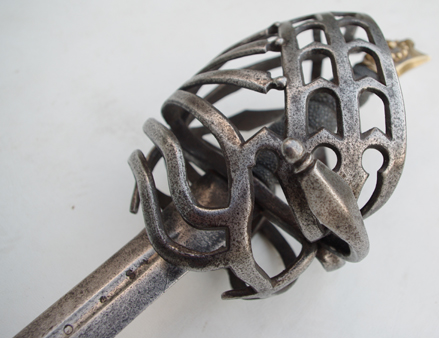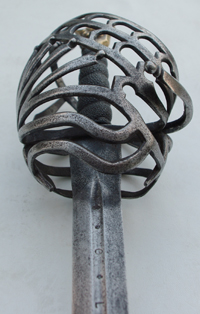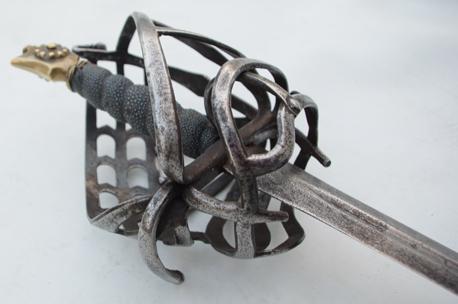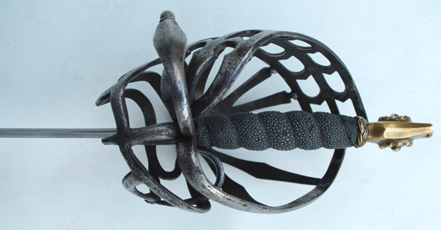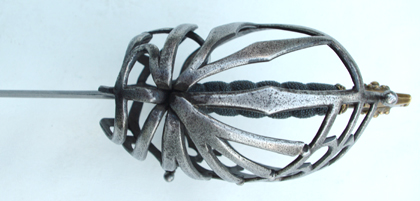I have recently taken a big step with my collection, and I have purchased a wonderful antique schiavona. This piece is in very good condition, showing some surface corrosion, and with a very slight wiggle on the guard. Other than that, the rest of the hilt components are rock solid, and the patina isn't bad at all.
Overall length: 40 inches
Blade length: 34 inches
Blade width: 1 7/16 inches at guard
Point of Balance: 3 1/4 inches from guard
Grip length: 4 inches
Guard width: 4.5 inches
Opening for hand width: 3.5 inches
Oakeshott Type 2b schiavona guard
[Edit] Weight: 2 lbs 9.3 oz
I unfortunately can't seem to find my scale that I normally use for weighing swords, so I had to use a fairly innaccurate bathroom scale, which says the sword is roughly 2 1/2 lbs. It feels lighter: The sword has a wonderful balance for both cutting and thrusting, and it is made even livelier by the thumb ring inside the guard, which really aids in the way I am able to make cutting actions. The tip control is excellent, and I've been doing light solo drills in the Bolognese tradition with it because it feels so "right" for the actions. The blade is quite thin and still sharp. In fact, it has the type of blade that many well-meaning modern enthusiasts would unfortunately call "whippy", which is not only historical (as is evidenced here), but quite common on thin cutting blades such as this.
The grip is wrapped with rayskin with a spiral groove. There is evidence that there may have once been a wire that laid in that groove, but is now gone.
Dating the sword is tricky. The blade has the engravings "S-O-L-I D-E-O" on one side and "G-L-O-R-I-A" on the other. This roughly means "For the Glory of God Alone", and this is one of the five sola of the Protestant Reformation (five Latin phrases that encapsulate the movement's beliefs). The Protestant Reformation is generally accepted to have ended at about 1648, so that most likely places the age of the blade in the first half of that century.
I do not know for certain if the guard is also from the 17th c, as it is not uncommon for these blades to be fitted to guards later in life. It is also not out of the realm of possibility that the sword is composite of multiple schiavona parts. I've been spending quite a lot of time trying to figure out what time period the guard is from, and I'm still not 100% certain. There are a number of guards that are more or less exactly like this dated anywhere from the middle of the 17th century into the middle of the 18th century, and Oakeshott himself laments the troubles of dating these hilts in European Weapons and Armour from the Renaissance to the Industrial Revolution. I'm suspecting it is a 17th century hilt based on its similarity to many other 17th century hilts, but can't be completely sure because there are some 18th century ones that aren't that different as well. If anyone else has any information regarding this, I would highly appreciate it!
Needless to say, I'm quite enamoured with this sword. I had to sell a couple of my more highly prized modern reproductions to afford it, but I don't regret that for a second. To have such a wonderful piece of history in my possession is both exciting and an honor, and I intend to let students handle and examine it so that others can better appreciate this wonderful weapon.
(I have more photos, which I still have to resize. I'll add them later on tonight.)
*edited to fix typo in stats*

